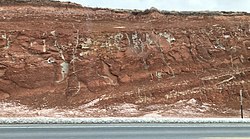Earth:Bell Springs Formation
From HandWiki
Short description: Stratigraphic Unit in Wyoming and Utah
| Bell Springs Formation Stratigraphic range: Norian-Rhaetian ~221–202 Ma | |
|---|---|
 | |
| Type | Geological formation |
| Lithology | |
| Primary | Sandstone |
| Location | |
| Coordinates | [ ⚑ ] : 43°00′N 108°48′W / 43.0°N 108.8°W |
| Paleocoordinates | [ ⚑ ] 19°12′N 46°24′W / 19.2°N 46.4°W |
| Region | Wyoming |
| Country | |
| Lua error in Module:Location_map/multi at line 27: Unable to find the specified location map definition: "Module:Location map/data/Wyoming" does not exist. | |
The Bell Springs is a member of the Nugget Sandstone in Wyoming and a formation in Utah.[1] It is a Late Triassic (Norian to Rhaetian)[2] Fossil theropod tracks assigned to Agialopous wyomingensis have been reported from the formation.[3][4]
The formation composed of very fine grained limy sandstone that is distinguished from upper part of Nugget by presence of red to purple-red shale and lime cemented siltstone in beds less than 0.1 ft thick and by presence of calcareous firmly indurated beds 1-4 ft thick that are ripple laminated and weather to square faced ledges. May correlate with upper part of Chinle Formation. [5]
See also
- List of dinosaur-bearing rock formations
- List of stratigraphic units with theropod tracks
References
- ↑ "National Geologic Map Database". https://ngmdb.usgs.gov/Geolex/Units/BellSprings_6808.html.
- ↑ Bell Springs Formation at Fossilworks.org
- ↑ Weishampel et al., 2004, pp.517-607
- ↑ Branson & Mehl, 1932
- ↑ Pipiringos, G.N., 1968, Correlation and nomenclature of some Triassic and Jurassic rocks in south-central Wyoming, IN Shorter contributions to general geology, 1967: U.S. Geological Survey Professional Paper, 594-D, p. D1-D26.
Bibliography
- Weishampel, David B.; Peter Dodson, and Halszka Osmólska (eds.). 2004. The Dinosauria, 2nd edition, 1–880. Berkeley: University of California Press. Accessed 2019-02-21. ISBN:0-520-24209-2
- Branson, E. B., and M. G. Mehl. 1932. Footprint records from Cretaceous, Triassic, and Pennsylvanian. Bulletin of the Geological Society of America 42. 284–285.
 |

